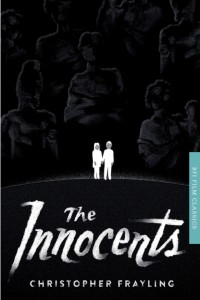The Innocents (BFI Film Classics) by Christopher Frayling (BFI Palgrave Macmillan, October 2013). 120 pages. ISBN: 978-1844573431 (paperback). £10.99
 About the Reviewer: Josephine Botting is a fiction curator at the BFI National Archive where she programmes film seasons and hosts events. She has contributed to the BFI books 39 Steps to the Genius of Hitchcock and Ealing Revisited (both 2012) and Gothic: the Dark Heart of Film (2013) as well as other BFI publications and online resources. She is currently completing a PhD on British film director Adrian Brunel. She is the producer of the BFI Flipside release, Her Private Hell.
About the Reviewer: Josephine Botting is a fiction curator at the BFI National Archive where she programmes film seasons and hosts events. She has contributed to the BFI books 39 Steps to the Genius of Hitchcock and Ealing Revisited (both 2012) and Gothic: the Dark Heart of Film (2013) as well as other BFI publications and online resources. She is currently completing a PhD on British film director Adrian Brunel. She is the producer of the BFI Flipside release, Her Private Hell.
 The BFI’s Film Classics are a wonderful and much-copied idea: a series of rich and diverse monographs on both established screen classics and classics-in-the-making. Authors and titles are paired to bring the subject to life and enlighten the reader, enhancing the enjoyment and understanding of a film text. The cover designs for several titles have recently been updated and the artwork produced by Matt Young for this special edition, part of the BFI’s Gothic offering, is particularly striking.
The BFI’s Film Classics are a wonderful and much-copied idea: a series of rich and diverse monographs on both established screen classics and classics-in-the-making. Authors and titles are paired to bring the subject to life and enlighten the reader, enhancing the enjoyment and understanding of a film text. The cover designs for several titles have recently been updated and the artwork produced by Matt Young for this special edition, part of the BFI’s Gothic offering, is particularly striking.
One of the most pleasurable aspects of the series is the different, often very personal, approaches taken by each author and in The Innocents, Sir Christopher Frayling’s scholarly interest in, and affection for, Jack Clayton’s 1961 film comes clearly across. Frayling has undertaken extensive research into the director’s personal papers, now housed in the BFI Special Collections department, in order to chart the stages in the development of the project. Delving into the director’s past, Frayling puts forward the view that Clayton’s lack of a father offers an explanation for his particular interest in the story of two orphaned children; and asserts that Clayton was the driving force behind the film, resisting the attempts of the executives at Twentieth Century Fox to water down some of its more controversial aspects.
The book is littered with interesting asides, such as the fact that Cary Grant turned down the role of ‘the uncle’ (eventually played by Michael Redgrave) because Clayton refused to introduce a scene for him at the end of the film. We also learn that Clayton kept the white pigeons used in the film and went on to become a very successful pigeon breeder.
Frayling describes in detail scenes and dialogue that didn’t find their way into the film, leading to a bit of an information overload that can only be worked through by undertaking at least one, probably several, rigorous viewings of the film (no bad thing of course). Despite this, he does manage to weave in many examples of how he thinks the filmmakers succeeded in producing one of the best ghost movies ever made – among them the casting of Deborah Kerr, the skilful use of the widescreen format to suggest something lurking at the edges of the frame and the restraint in both the screenplay and the visuals.
The book is illustrated mainly by frame grabs of varying quality – obviously selected to illustrate points made in the text – but of more interest are the production stills (particularly one of Kerr knitting in her dressing room in between takes) and designs for Miss Giddens’ costumes, unfortunately only rendered in black and white.
Frayling starts his analysis at the very beginning, outlining the origins and publication history of Henry James’ 1898 source novella, The Turn of the Screw, before discussing the stage version first produced in the early 1950s. This takes up nearly a third of the volume and is followed by a detailed investigation of the various incarnations of the screenplay, which was worked on by three writers: William Archibald (author of the stage version), John Mortimer and Truman Capote, as well as having considerable input from Clayton himself. This analysis, while very interesting and of great value to film scholars, eats up another fifty pages of Frayling’s 108-page limit.
... the book is clearly a labour of love and a worthy addition to the series
This tally of the pages may sound pedantic but there is a point to it; Frayling’s in-depth analysis of the archival material leaves little space to really explore the poetic heart of the film itself. It feels as if there is a much longer book trying to get out and the three-page final chapter covering the film’s release and critical failure comes to a rather abrupt end, giving the impression that the author was rather restricted by the form. However, this is a minor criticism of the book that is clearly a labour of love and a worthy addition to the series.
Josephine Botting